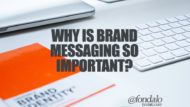One of the things I have enjoyed about my recent career transition out of a tech start-up and toward a job search is talking to a lot of people and brands about their product, messaging and marketing challenges. Over the past several months I have been able to do some consulting projects as well as conduct several informal calls with startups and growing businesses that have sought me out. I am being asked A LOT of questions right now and many of them revolve around the product, messaging and marketing triangle.
At the core of the product, messaging and marketing triangle is the actual problem that is being solved for your customers. In other words, what is the specific pain point or points that your product is solving for them. Your product or service should be a reflection of clearly understanding and defining the problem your prospective customers have. Then your messaging should define your product as the solution for that problem.
For example the automobile solved many pain points for industry by solving their lengthy distribution times, extending their reasonable market delivery areas and reducing the costs and infrastructure requirements using horse and wagon. The product itself solves a really big problem that was widely apparent to everyone. Therefore the messaging and marketing that supported the early automobile was simple to understand.
Is The Problem You’re Solving Really Big Enough?
This is a question that is not asked often enough by marketers developing messaging and marketing strategies. The answer to this question cannot be subjective or a gut feeling, you really have to do the research and know the numbers before you begin developing or modifying your existing message and marketing.
3 ways to answer this question:
1. Research – One of the most time-consuming and challenging things you MUST do is conduct research. You need to uncover data that supports the problem you are solving for your customers. Here are some examples of the kind of data you need to know in order to determine whether the problem you are solving is really big
– How big is the total industry market you are in? (total addressable market) You can start with the main industry such as manufacturing or online software as an example. IBISworld is a good place to start. *If you are a local business this research would be very different from if you are an online business.
– How big is your direct industry market? (serviceable addressable market) In other words how big is the market for YOUR type of manufacturing or software.
– What is YOUR share of the market? (share of market) How much of that market could you reasonably expect to garner? What are your target customers spending annually now to try to resolve their problem?- What are the direct trends driving your industry disruption?
– What specific customer base has this big problem? example: consumer 25-35 or executives in manufacturing.
2. Survey Prospects – The second thing you should do before creating or modifying your product messaging is ask people about the problem(s). Conduct surveys with your prospective customers asking them about the biggest problems they have, what they like and dislike about current competitors, etc.
You want to conduct these surveys with people you DO NOT know. You want completely unbiased answers that will give you validation for your product. You will also want to make sure that the questions you ask are not leading in any way. The end result should be prospective customers validating the problem you are solving is either big enough or not and whether the solution you are going to provide fits their needs. Finally, you should be able to also establish what they would be willing to pay to solve their problems.
3. Know Your Competition – Lastly in the process you really need to understand your competition. What are they really good at and what are they missing. You need to know how much market share they have, their product and price points as well as what makes them unique.
Bring these three components of knowledge together will enable you to develop messaging and marketing strategies from a standpoint of data and strength, rather than gut feelings, which are often wrong!
Even local retail startups and brands need to understand these principles if they are going to compete. Another mouse trap doesn’t ensure success. A new mousetrap that is far superior in definable ways can be. Maybe. You have to not only know what your customers want and need, but refine your product, messaging and marketing into something that resonates with them enough to get them to act.
Many startups, brands and marketers have not spent enough time quantifying the problem/solution fit and therefore end up struggling with messaging and marketing. They often build and deploy products and services without understanding if they are actually solving a really big problem for their prospects. Though their idea might be interesting or cool, frequently it isn’t a big enough problem and therefore the need is not large enough. If the need is not really big, it will inevitably make product messaging and marketing considerably more challenging.
Brands that have already deployed their product and are struggling to get traction, need to step back and work through their product again and answer the “big enough” question. This should be done before making changes to messaging and marketing efforts or I can assure you that you will end up on a merry-go-round, going nowhere. It is also extremely important to note that many established businesses that go through this process are going to have to “pivot” their product in order to have a niche that is big enough. Failure to make appropriate product changes before modifying marketing and messaging will be disastrous in many ways.






